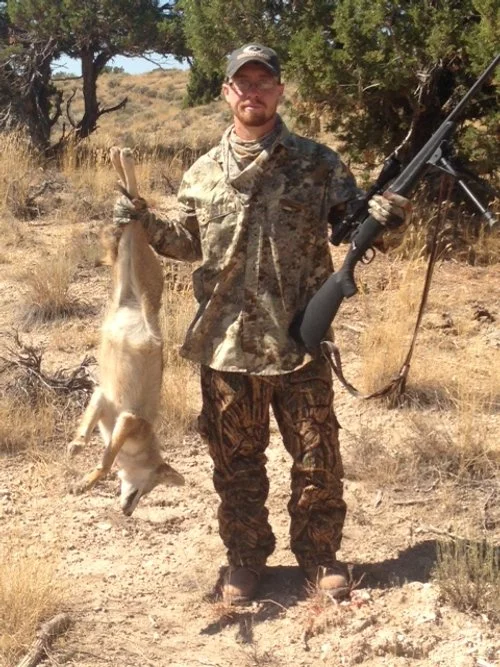Using Technology To Find Hunting Spots
Using your computer to find coyotes
Finding good places to hunt coyotes can be challenging, time consuming, and expensive. Any time you can reduce the number of miles you drive and footsteps you take will increase the amount of actual hunting time you can spend on calling stands. It can also save you money at the gas pump.
A little at home scouting helped me find this young coyote, his first, for our friend, Wyatt. After narrowing down new hunting options, Google Earth helped me locate a grassy opening that was screened from the road by a band of thick junipers.
Finding general areas to hunt
Starting with the widest spectrum, which state in your area offers the best hunting opportunities? A simple Google search of “Best states to hunt coyotes” will get you started. Although not all the information on the web is valuable and/or accurate, when several different sites list the same states, you can be pretty sure the information will be fairly accurate.
My quick search showed that 20 of the 50 states appeared on at least one list, indicating that you can really find coyotes almost anywhere. The top ten, that appeared on multiple lists, were Wyoming, Idaho, Montana, Nevada, Arizona, New Mexico, Texas, Colorado, Kansas, and California. Also mentioned were Alabama, Alaska, Arkansas, Delaware, Georgia, Nebraska, Utah, Washington, and Oregon.
Once you decide on a state, or commit to your home state for travel/expense reasons, you can dig a little deeper.
In my home state of Utah, the Mule Deer Protection Act offers a bounty for harvested coyotes and collects data on those submitted for bounty. Each year they publish the findings and part of that information is the area of harvest. The number of animals turned in by county is listed as well as a map showing the general location of kill locations.
Once you have narrowed down your search area, it’s time to get serious.
Google Earth and onX Hunt are excellent tools to locate hunt areas. onX Hunt not only provides map and habitat information, but also shows property ownership. This will help you stay off private land and out of trouble with landowners and authorities. It can also help you track down property owners and help you contact them for permission to hunt.
OnX can also be used as an overlay on Google Earth to help pinpoint hunting locations.
On Google Earth, zoom into the area you would like to hunt and start looking for good habitat. Pay attention to agricultural areas, fence lines, water sources, breaks in the terrain, burn areas, reseedings, etc. Look for anything that might attract coyotes.
Locate the roads in the area and start pinpointing possible stands. Look for terrain or vegetation that will hide your truck. Look for places you can park that offer easy access to stand locations. Check the weather forecast to determine expected wind direction and look for sitting spots that will put the wind in your face and the sun at your back.
This clip from Google Earth shows a nice open area with good cover, a slight elevation to overlook the area and a screen of Junipers that hides the area from the view of anyone driving on the paved highway at the top of the picture. I walked about 100 yards from where I parked the truck and called in a double at this spot.
When I’m going to a new area I will drop pins on the screen at the places I’d like to try. I will label them as to which might be better for morning hunts and which will have me facing east with the sun at my back for evening hunts. I usually figure on about an hour for each stand, so will try to locate enough stand locations to last the entire day, with another 10% or so in case some of the other stands don’t work out for some reason.
I have an artificial knee, so I prefer to have my stands about ¼ mile (or less) from where I park the truck. Google Earth has allowed me to locate good stands that fit this criteria. I look for areas with good visibility and some elevation that may be screened by vegetation, rocks, or ridges. Thanks to this tool, I have been able to kill nine out of my last 11 coyotes 400 yards or less from where I parked the truck.
Don’t overlook the weather forecast. My go-to weather site is the NOAA Forecast page. https://www.weather.gov/
By clicking on your state, and then the area of the state you plan to hunt, you will be taken to a page that has information on precipitation, wind direction and speed, cloud cover and more. If weather forecast is not optimal for your first choice area, you can often search nearby and find better conditions.

